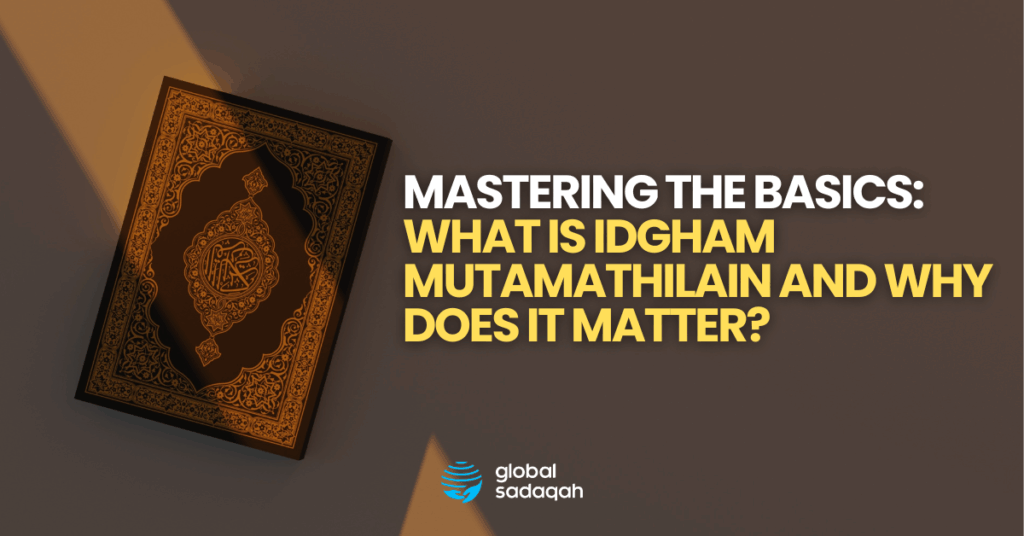The Foundation of Beautiful Recitation: Understanding Tajweed
The Quran is not just a book to be read; it is a sacred text to be recited with precision and reverence. This precision comes from Tajweed (تجويد), the science that dictates the proper pronunciation, articulation, and rhythm of the Quranic text. Adhering to Tajweed ensures that we recite the words as they were revealed, preserving their meaning and spiritual impact.
One of the fundamental and frequently occurring rules in Tajweed is Idgham (merging or assimilation), and its simplest form is known as Idgham Mutamathilain.
What is Idgham Mutamathilain?
The term Idgham Mutamathilain (ادغام متماثلين) is an Arabic phrase that literally translates to:
- Idgham (ادغام): To insert, merge, or assimilate one thing into another.
- Mutamathilain (متماثلين): Two identical things; two of the same kind.
The Rule Defined
Idgham Mutamathilain occurs when two identical letters appear consecutively in the recitation, provided that:
- The First Letter is Saakin (has a Sukoon ( ْ )—it is non-voweled/silent).
- The Second Letter is Mutaharrik (has a Harakah ( َ ِ ُ )—it is voweled).
When these two conditions are met, the first silent letter is completely merged into the second voweled letter, resulting in a single, doubled and stressed letter (indicated by a Shaddah ( ّ )).
Why “Identical Letters”?
In Tajweed, “identical letters” means they share both the:
- Makhraj (مخرج): The same specific articulation point (e.g., both are pronounced from the tip of the tongue, the lips, etc.).
- Sifaat (صفات): The same characteristics (e.g., softness, strength, heaviness, lightness).
Since the letters are the same, the merging process is the most straightforward and complete (known as Idgham Kamil).
How Does the Rule Look in Practice? (With Examples)
The easiest way to identify Idgham Mutamathilain is to look for any letter with a Sukoon followed immediately by the exact same letter with a Harakah.
1. The Baa (ب) Example
- Original Letters (Conceptual): اضْرِبْ بِعَصَاكَ
- Recitation (Merged): اضْرِب بِّعَصَاكَ
- Note: The first ب (silent) is merged into the second ب (voweled). You pronounce one heavy, stressed ب. (Example: Idhrib-bii’asaak)
2. The Kaf (ك) Example
- Original Letters (Conceptual): لَكُمْ كَانَ
- Recitation (Merged): لَكُم كَانَ
- Note: The first ك (silent) merges into the second ك (voweled), creating a stressed ك sound. (Example: Lakum-makaana)
The Crucial Exceptions: Mutamathilain with Ghunnah
While most cases of Idgham Mutamathilain do not require a nasal sound (Ghunnah), there are two critical letters that do: Meem (م) and Noon (ن).
A. The Meem (م) Rule (Idgham Shafawi)
When a silent م (مْ) is followed by a voweled م (مَ, مِ, or مُ), the rule is still Idgham Mutamathilain, but it is specifically called Idgham Shafawi (Mouth/Lip Merging) and requires a Ghunnah of two counts.
- Example: وَلَكُم مَّايَجْزُرُونَ (Wa lakum maa yajzuroon)
- Recitation: The first م is merged into the second with a two-count nasalization.
B. The Noon (ن) Rule
When a silent ن (نْ) is followed by a voweled ن (نَ, نِ, or نُ), the merging also requires a Ghunnah of two counts.
- Example: مِنْ نُّورٍ (Min noorin)
- Recitation: The نْ is merged into the ن with a two-count nasalization.
Why Idgham Mutamathilain Matters
Understanding and applying this rule correctly is crucial for several reasons:
1. Preservation of Meaning
In Arabic, mispronouncing or omitting a letter can drastically change the word’s meaning. Tajweed rules, like Mutamathilain, ensure that the reciter pronounces words exactly as intended, protecting the clarity of Allah’s message.
2. Achieving Musicality and Flow
Reciting the Quran according to Tajweed creates an inherent flow and rhythm. Failing to merge the letters would result in a jarring break in the sound, forcing a stop and a restart. Idgham Mutamathilain eliminates this break, allowing the recitation to flow smoothly and beautifully, making the listening experience more profound.
3. Spiritual Reward (Ajr)
The Prophet Muhammad (peace be upon him) said: “The one who recites the Quran beautifully, regularly, and with mastery, will be with the noble and obedient angels.” Mastering Tajweed is an act of devotion, demonstrating respect for the Quran and earning greater spiritual reward.
Conclusion: Start Your Tajweed Journey Today
Idgham Mutamathilain is often the simplest rule of Idgham to master because the letters are perfectly identical. By focusing on finding the silent letter followed by its twin, you can immediately elevate your recitation. Take time today to review the first few pages of the Quran and identify where this simple, yet powerful, rule occurs!

